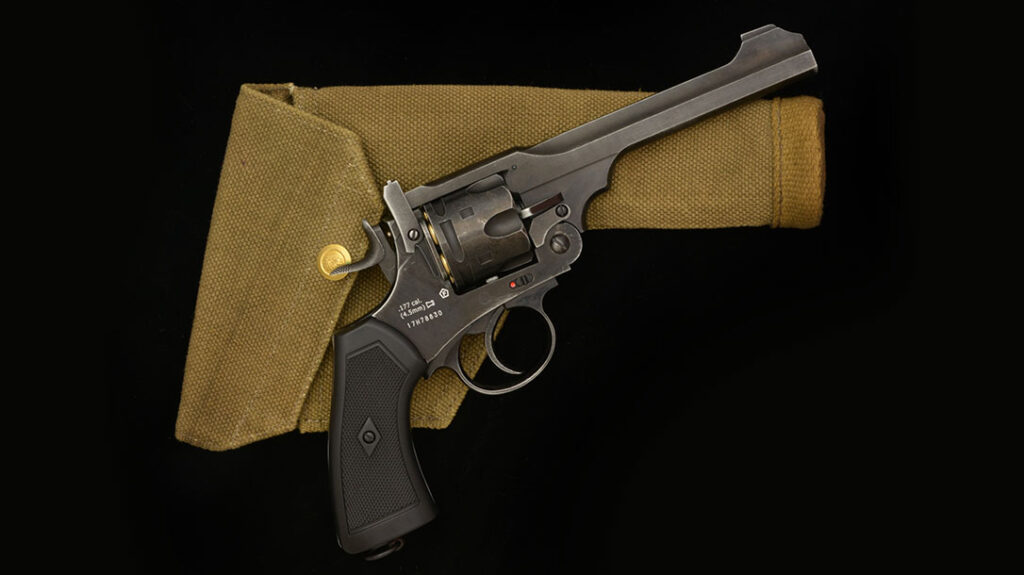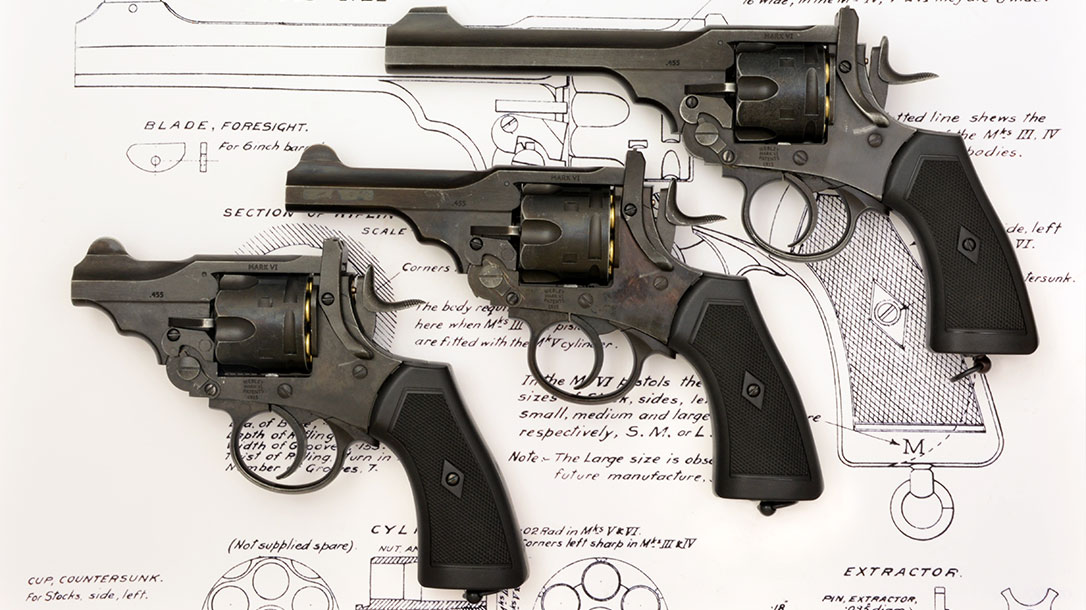There is an almost inexplicable attraction to early military revolvers that has not diminished with the passing of years. Particularly from famed British arms maker Webley & Scott. The British Empire’s venerated .455 caliber Webley Mk VI revolver has not lost its attraction (among arms collectors). Nor has it lost its international recognition as one of the best handguns of all time.
The Webley 4.5mm Mk VI Revolver
The Webley is also one of those classic handguns that have been prominently featured in countless motion pictures.
This includes the following examples:
Advertisement — Continue Reading Below
- 1962’s Lawrence of Arabia, carried by Peter O’Toole as T.E. Lawrence
- Richard Burton used an Mk VI in the WWII classic The Longest Day
- Robert De Nero, as a young Vito Corleone in The Godfather Part II, used a Mk VI to shoot Don Fanucci outside his apartment in the flashback to New York City in 1920
- Lest we forget the Webley WG (Army Model with bird’s head grip) used by Harrison Ford in two Indiana Jones adventures, The Last Crusade and The Kingdom of the Crystal Skull
- And the significant presence of the Webley Mk VI in the 2019 Oscar-nominated film 1917.
Thus, after Webley introduced its .177 caliber BB version of the Mk VI in 2015 (imported by Pyramyd Air), it not only caught the attention of arms collectors and airgun enthusiasts but also movie buffs!
Webley followed up with a 4.5mm rifled barrel, pellet cartridge loading model. It features an aged Battlefield Finish giving it a very distinctive and authentic military look. The Mk VI models have since become some of the most popular of all Webley & Scott air pistols.
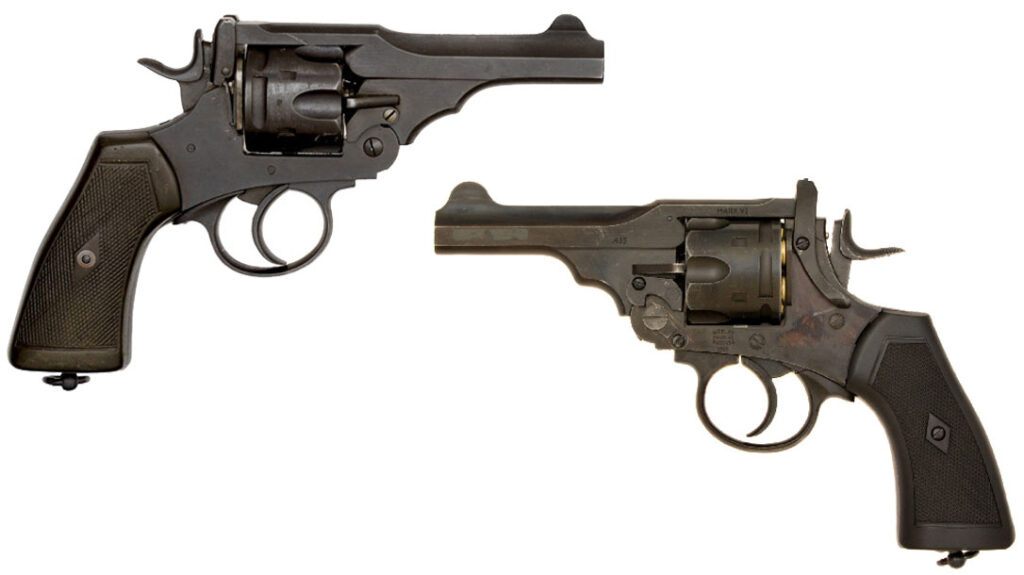
Advertisement — Continue Reading Below
Webley’s history with airguns
Webley & Scott is a company steeped in a storied air pistol history dating back to the early 20th century. It began with the Webley Mk I air pistol in 1924. Then, in recreating the c. 1915 Mk VI, Webley & Scott followed its original .455 caliber specifications in exacting detail.
The 1915 Webley Mk VI Self-Extracting Revolver became one of the most distinguished British handguns. British soldiers carried it in both WWI and WWII.
The Webley topbreak design was first adopted by the British military back in 1887 with the Webley Mk I. This is the same designation given to the company’s first air pistol.
Advertisement — Continue Reading Below
The topbreak design evolved over nearly 30 years, culminating in the Mk VI variations. They were produced in two series beginning in 1915 and kept in service until 1947. The smaller .38 caliber Webley Mk IV remained in service even longer until 1963!
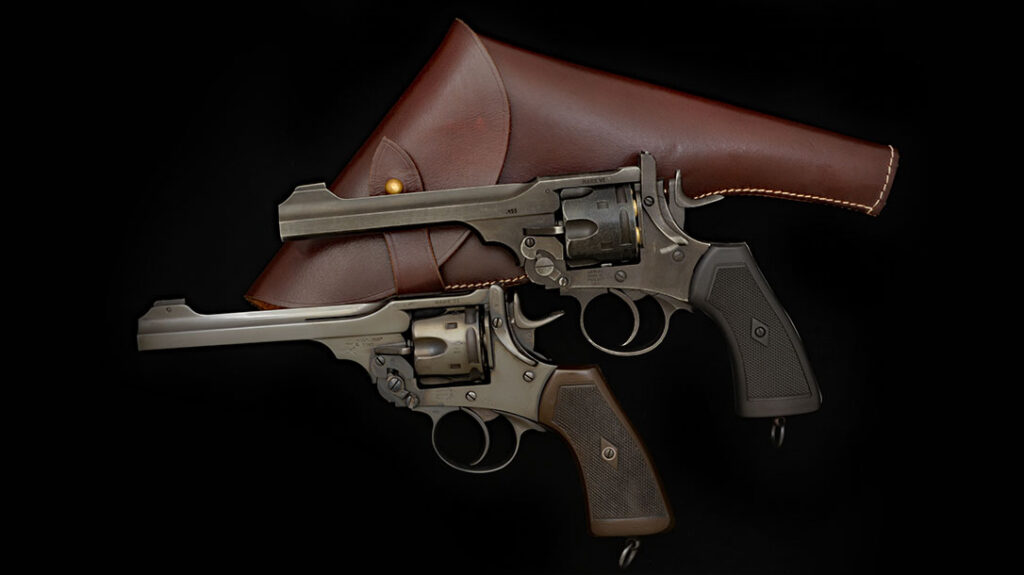
The Distinctive Look of the Mk VI
The Mk VI’s distinctive look was enhanced by a square-butt grip with a lanyard ring. Military models also had a dull finish that was less reflective than the blued finish previously seen on Webley & Scott military sidearms. Commercially produced blued models were also available for the civilian and law enforcement markets.
Advertisement — Continue Reading Below
There were many characteristic features of the Webley design duplicated in the air pistols. These include the flat-sided 6-inch, 4-inch, and 2.5-inch barrel lengths, the original large hammer spur, copious trigger guard, and large crescent-shaped double action, single action trigger.
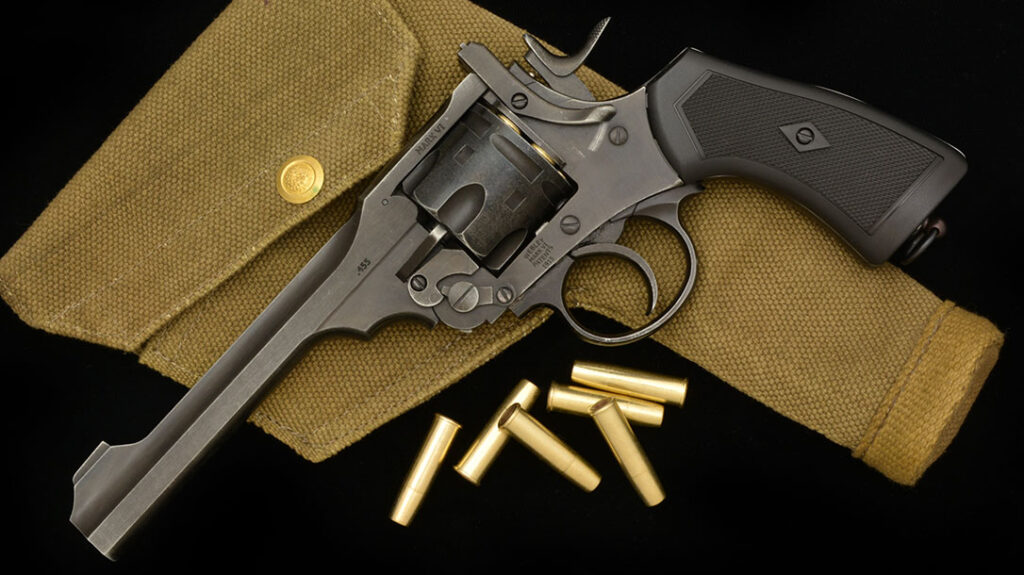
The original Mk VI was a man-sized handgun overbuilt to endure. While some might consider its appearance less than attractive, it’s still a matter of opinion more than a century later. A Webley is unmistakable, especially with the gun’s massive “stirrup latch.”
Advertisement — Continue Reading Below
Hard to miss when reloading, the large release lever on the left side of the frame is pushed down to pivot and unlatch a locking bar over the back of the topstrap. Thus freeing the barrel assembly to be tilted downward.
Like the old S&W topbreak revolvers, opening the Webley activates an automatic ejector (working off an external cam lever on the left side of the frame). This drives the cylinder pin and extractor upward and simultaneously expels all six spent shell cases. This was still a very efficient design despite the advent of the swing-out cylinder and hand ejectors introduced by Colt and S&W in the late 19th century.
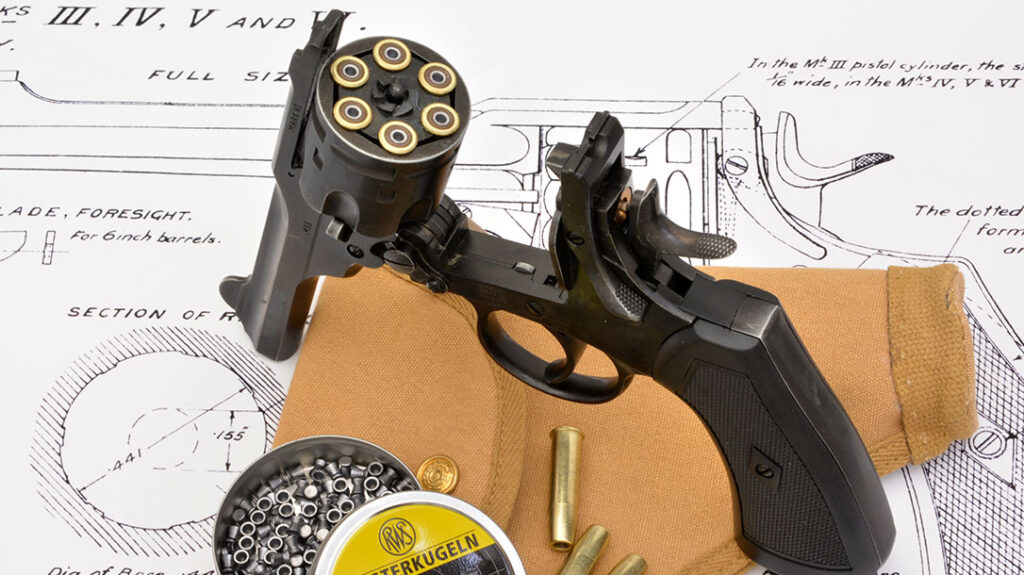
Advertisement — Continue Reading Below
In addition, the triangular-shaped cylinder retaining cam on either side of the Webley frame had an added purpose. It spread open the holster pouch to prevent the cylinder from catching on the edges when re-holstering!
Webley Offers an Accurate Reproduction
All of these detailed features are accurately reproduced in the Webley Mk VI air pistols. This is except for completely ejecting the unique pellet-loading metal cartridges, which can be reused. You don’t want to go hunting for them on the ground!
It weighs in at 37 ounces (for the 6-inch model) and measures an exact 11.25 inches in length and 5.75 inches in height. As a result, the Mk VI air pistol is as close to the original Webley specs as possible.
Advertisement — Continue Reading Below

The Battlefield Finish has an exceptional true-to-era gunmetal finish. It shows wear to the edges of the barrel flats, muzzle, and edges of the cylinder flutes, triggerguard, and backstrap. There is even a wear line below the stirrup latch release lever on the frame.
However, the most valuable characteristic of the surface wear on the MK VI model is the sights. They have faded edges that provide a better outline of the rear notch and front blade. This makes the sights easier to acquire and hold on target.
Advertisement — Continue Reading Below
Put to the Test
The double-action trigger pull on an original .455 Webley Mk VI is in excess of 12 pounds. Likewise, the single-action trigger pull averages 10 pounds 10.5 ounces. It’s not a gun for those lacking the confidence to pull the trigger. As intended by Webley, it’s a military pistol not prone to accidental discharges!
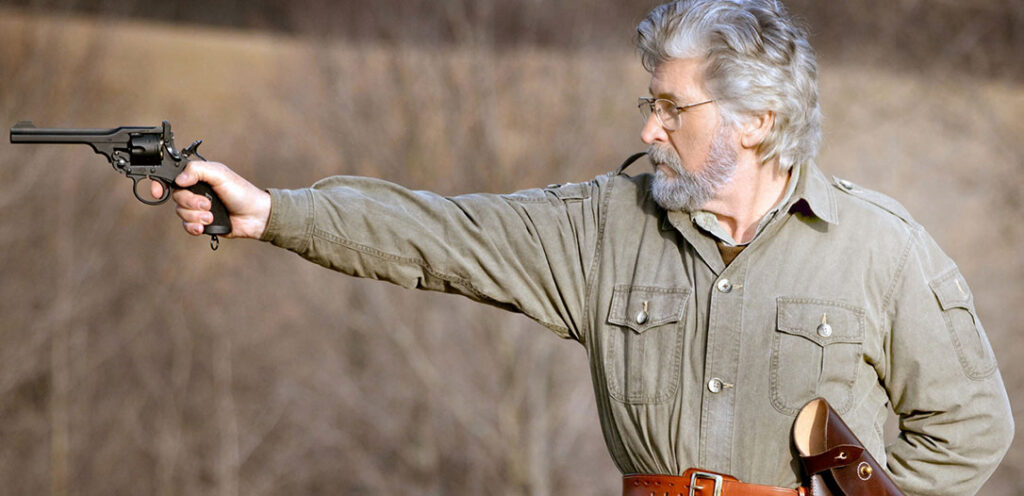
The 6-inch Webley Mk VI Service Revolver in 4.5mm is a bit more trigger-friendly. It has a double action pull averaging 7 pounds, 10.5 ounces, and a single action pull of 5 pounds, 5 ounces. Thus, making this a more suitable target shooting air pistol than its legendary .455 caliber antecedent.
Trigger pull on the 4-inch averaged closer to the actual 11 pounds, 15 ounces double action, and 5 pounds 6 ounces single action. The snub nose double action pull was 10 pounds, 13.5 ounces, and 5 pounds single action. Overall, close enough on all three to approximate the .455 caliber Mk VI model’s trigger pull.
Mk VI Actual
The Mk VI models built between 1915 and 1919 were fitted with 6-inch barrels. Only a small number (in the hundreds) were manufactured with the 4-inch barrel in the 1920s. They were all within the later Mk VI series produced from 1919 to 1923 under contract to Enfield. In total, more than 300,000 Mk VI revolvers were manufactured.
A snub nose 2.5-inch model is virtually non-existent in the Mk VI series. However, it was seen in the .38 caliber Mk IV and Mk IV New Service models. These were primarily 4-inch models resembling the larger caliber Mk VI.
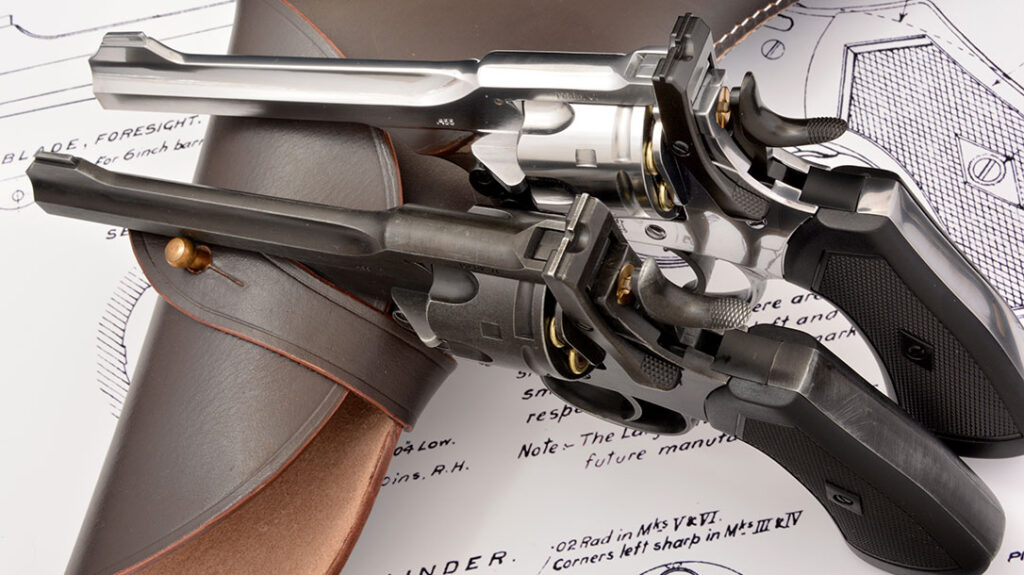
The CO2 pistol’s barrel length options are not all historically accurate. However, Webley & Scott designed them from the original centerfire cartridge model blueprints.
Not to mention, they are made for and marketed by Webley & Scott. So, who’s to say what’s accurate? After all, they invented the thing!
On the firing line at 10 meters
The optimum distance for testing a CO2-powered, rifled barrel pellet pistol is 10 meters.
At that range, firing single action offhand with a two-handed hold, the 6-inch model placed a best 6-shot group at 0.687 inches in the bullseye. This required a 1.5-inch hold-under from POA to POI. When firing double action, things begin to change.
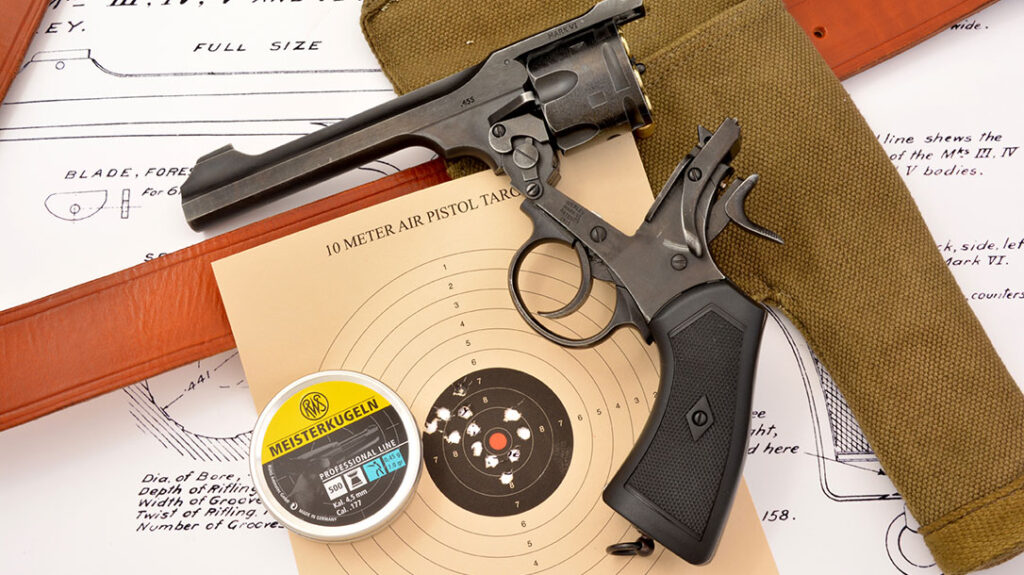
In fact, the reason double-action revolvers were invented in the first place was to make them faster to shoot than a single action (fanning doesn’t count). Cocking the hammer for a single-action shot with a double-action revolver was mostly a luxury.
Soldiers were trained to shoot double action, and so were British law enforcement officers (those who carried sidearms). Not to mention other British law enforcement agencies like the Singapore and Hong Kong Police, all of whom carried Webley revolvers well into the postwar WWII era.
Webley models were also used by the British military in India and Ireland. In fact, essentially anywhere in the world where the British flag flew in the early 20th century.
Running the MK VI in Double Action
The Webley was designed specifically for double-action use. So, in keeping with the gun’s intended purpose, the final test of the Battlefield Finish MK VI was double-action. I used a Weaver stance, a two-handed hold, and fired Meisterkugeln Professional Line 7.0 gr. lead wadcutter pellets. They clocked at 430 fps (the original 265-grain .455 Webley cartridge had a muzzle velocity of only 600 fps).
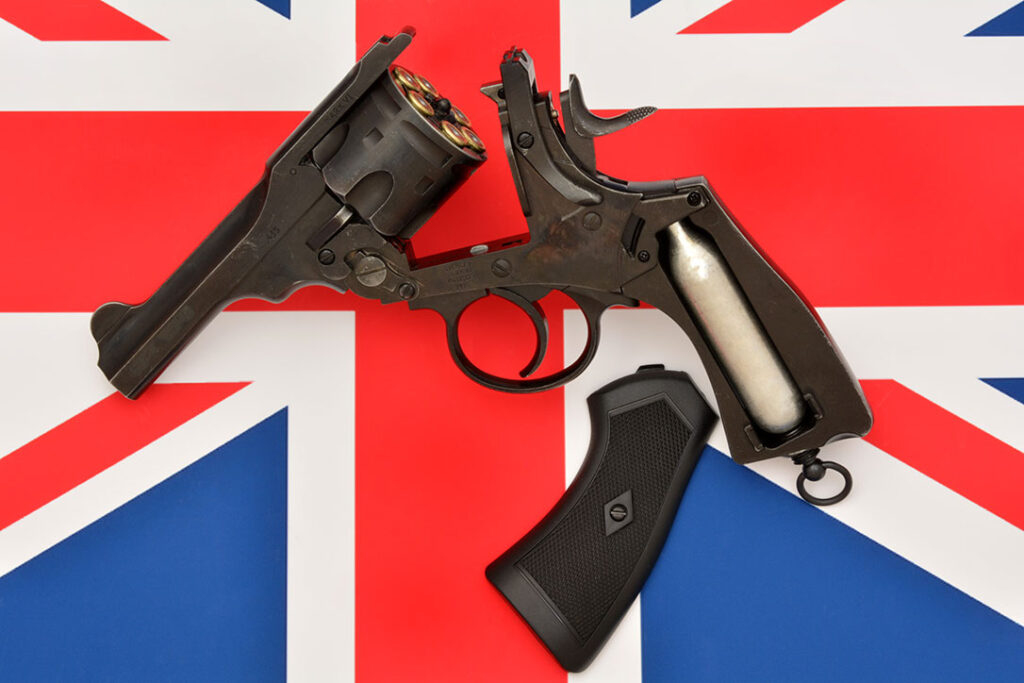
Trigger take-up on double action remained consistent from chamber to chamber for all six rounds. As previously noted, the weathered finish front sight is very easy to hold centered in the weathered gunmetal rear sight atop the stirrup latch.
I was able to cleanly stage the hammer for every shot. My best 6-shot group fired double-action in 1-second intervals measured 0.75 inches, with a second group measuring 0.937 inches. This is more than satisfactory for a pistol design developed in 1915.
Conclusion
As a precision shooting pistol, the Battlefield Finish MK VI does a decent job for a CO2 pistol priced at only $160 ($150 for the 2.5 and 4-inch models).
It is ideal for military arms collectors desiring authenticity to plinkers who like historic-looking air pistols. The Battlefield Finish Mk VI models have earned the right to wear the Webley & Scott name.
For more information, please visit PyramydAir.com.
